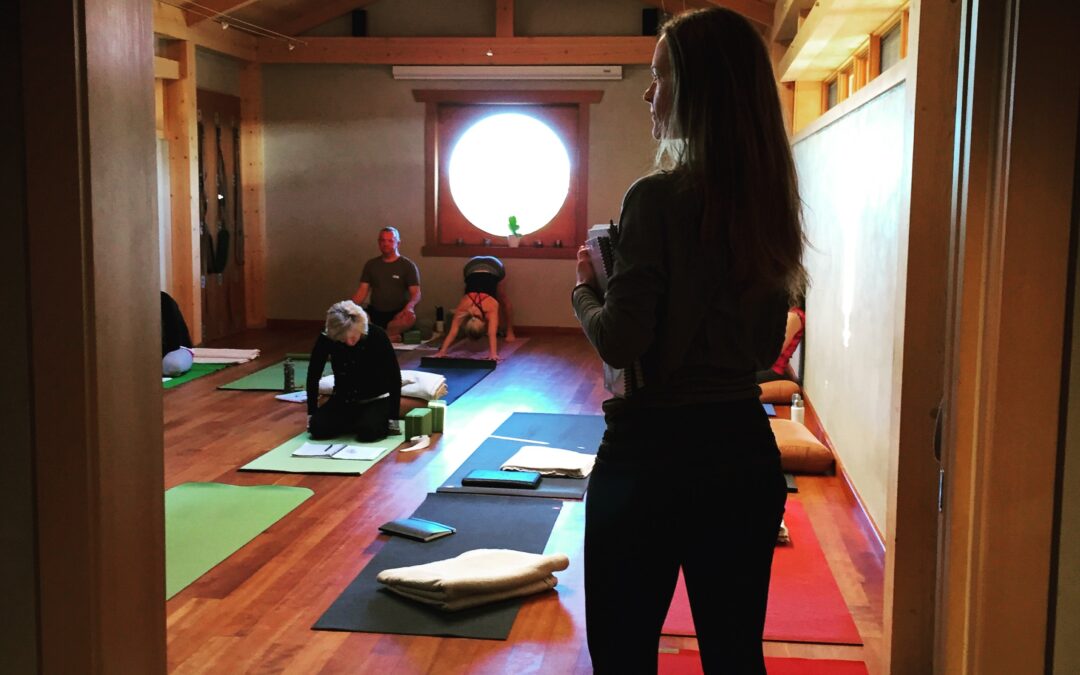Hanumanasana, or Monkey Pose, in its full expression, is the forward splits, a challenging pose that represents the pose Hanuman took as he leapt from the southern tip of India to Sri Lanka to rescue his good friend Ram’s wife, Sita, who had been kidnapped by the evil...
New to Yoga
Practices
Yoga in Your Daily Life
Yoga Beyond Asana
Sister Sciences »
Our Sangha »
Yoga Beyond Asana
The Healing Sound of Silence
Silent meditation, which you can experience in our weekly meditation class, is a way to quiet the mind and open the heart to the possibilities of the moment. Silence is a powerful tool that helps us turn inward and listen to the quieter voice that comes with insight....
Exploring the Myths of Asana—Bhujangasana
Bhujangasana, or Cobra Pose, represents our ability overcome fear. While the cobra is generally considered to be a creature that evokes fear, our ability to look past this initial instinct and view fear from a new perspective is key to helping us move past it. As...
Exploring the Myths of Asana—Natarajasana
Natarajasana, or King Dancer Pose, is the embodiment of King Nataraja, a depiction of Shiva, the god of destruction. Shiva represents change. With birth must come death; with destruction must come rebuilding. Nataraja represents Shiva as the ever-present change in the...
Play Tennis. Practice Yoga.
By Margit Bannon If you play tennis it’s not such a stretch (pardon the pun) to say that you might enjoy the practice of yoga, and if you practice yoga that you might enjoy tennis. Let’s consider the parallels between these two disciplines. As yogis we often...
Yoga for any Faith
One reason that yoga appeals to so many people is because, in addition to the great physical and mental benefits, its added spiritual/philosophical dimension can be integrated into a wide range of belief systems. When you hear the phrase, “Yoga is for all,” you may...
DIWALI: FESTIVAL OF LIGHTS
Diwali, which means "row of lights" in Sanskrit, is a celebration in India and around the world to honor the inextinguishable Light within all of us. It occurs in late October or early November every year on the New Moon when the two great luminaries of our solar...
Yoga Philosophy—A Practice Far Beyond the Mat
Yoga practice as we know it in the modern world tends to be heavily focused on the physical aspect of yoga. Western practitioners are first intrigued by the asana (postures) and pranayama (breath control) that are taught in yoga studios far and wide, but when we view...
Exploring the Myths of Asana—Trikonasana
Trikonasana, or Triangle Pose, is a symbol of trinity. Sacred trinities exist in so many forms in yoga. From the practical mind, body, and spirit or birth, life, and death to the more esoteric main energy channels (nadis) of ida, pingala, and sushumna or the three...

Sadhana: The Practice of Living with Purpose
The word Sadhana in Sanskrit means spiritual exertion towards an intended goal or the means of accomplishing something. According to Vedic teachings, that something is to live in a state of Self-realization, and any discipline or practice undertaken for ego-transcendence, freedom from suffering, or spiritual liberation is the final goal of life.

The Sacred Sound of Om
If you’ve been to a yoga class, chances are you’ve been invited to chant Om. Whether at the beginning of class to set the intention or at the end to close the practice, chanting Om offers a way to anchor into the present moment and connect with something beyond ourselves.
Exploring the Myths of Asana—Sanskrit
Yoga is a centuries old practice with a rich philosophy steeped in the ancient language of Sanskrit. A language once rarely spoken by people in everyday life, Sanskrit is being revived in India such that over 14,000 people currently consider it to be their native...
Guru Purnima
Teacher Appreciation Day By Gwen Burdick "Everything in the world has come out of one Divine Being, the sacred fire. The sages are the direct manifestation of that fire. No one understands them. No one talks to them. No one walks with them. They live in their own...
Without the Breath It’s Not Yoga
From an outward perspective, the practice of yoga seems very physical. An often continual progression of movements, yoga is rightly considered to be a physical exercise. But there is one element of the practice that sets it apart from other exercises—the breath. In...
Different Styles of Yoga
The most familiar form of yoga practiced in the West is Hatha Yoga, which is a combination of physical postures (asana), breath work (pranayama), meditation (dhyana), and relaxation. There are many different styles, or expressions, of Hatha Yoga. In fact, there are so...

Exploring Pitta Dosha
Pitta dosha is the mind-body constitution composed of the fire and water elements. These elements give Pitta individuals qualities such as intensity, sharpness, and responsiveness. People with a dominant Pitta dosha are often sociable, knowledgeable, and highly driven.

Auspicious 108
The number 108 is considered an auspicious, or sacred, number. For this reason, a traditional japa mala, or prayer garland, has 108 beads. It’s also why many practitioners take on the challenge of 108 sun salutations during the summer and winter solstice. Across many cultures and traditions, 108 is seen as a symbol of wholeness, unity, and the totality of all that exists. In yoga, it’s woven deeply into our practices and teachings. Read more for a glimpse into why 108 is considered so sacred.

Exploring Vata Dosha
Vata dosha is the mind-body constitution composed of the air and space elements. These elements give Vata individuals qualities such as lightness, movement, and creativity. People with a dominant Vata dosha are energetic, talkative, and always seeking new experiences. Known for their optimism and curiosity, Vatas are natural idea generators.

Understanding the Doshas: Your Ayurvedic Mind-Body Constitution
The doshas are the three primary mind-body constitutions in Ayurveda, the 5,000-year-old sister science to yoga. Ayurveda teaches that everything in the universe is composed of five elements: earth, water, air, fire, and space (also called ether). These elements combine in different ways to form the three doshas: vata, pitta, and kapha.
Hatha Yoga
Hatha Yoga is the branch of physical yoga. The practice of Hatha Yoga brings about steady posture, health, and lightness of the body, dealing with the physical aspects of the body. Hatha Yoga is the most familiar yoga practice in the West. It is described in the...
